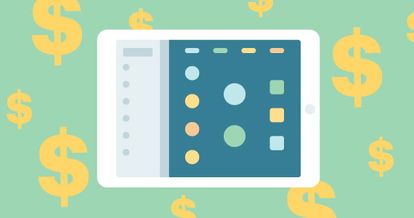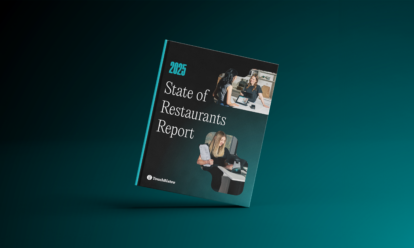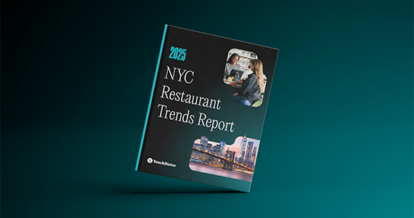Since it was first introduced, POS hardware like the iPad has been embraced by many companies as a flexible and efficient business tool. However, the hospitality sector wasn’t quite as quick to adopt the restaurant iPad.
Much like the way U.S. restaurants have long been wary of contactless payments, many initially viewed the restaurant iPad as less secure than traditional legacy POS systems.
However, these initial fears were quickly dispelled and restaurateurs have since begun to embrace the restaurant iPad in droves. With major benefits such as faster table turnaround time and more streamlined operations, the iPad restaurant POS system is quickly becoming the new standard.
And the benefits of using an iPad for business have only been amplified in the wake of COVID-19, as much of the restaurant experience has now become contactless. In the wake of this new reality, a growing number of venues are making the switch from their bulky legacy systems to a mobile restaurant POS iPad.
If you’re wondering what kind of benefits a restaurant iPad can offer your business, you’ve come to the right place. In this article, we’ll cover:
- What is an iPad restaurant POS system
- The differences between an iPad restaurant POS and a legacy system
- The differences between an iPad restaurant POS system and an Android POS system
- 15 benefits of an iPad for business

What Is an iPad Restaurant POS System?
Before we can explore the benefits of a restaurant iPad POS system, we have to address the question of what does POS mean and outline each component of a restaurant POS system.
POS stands for point of sale and refers to any place where a transaction is completed for a product or service, whereas a POS system is the actual hardware and software used to run and manage a business like a restaurant.
In the case of a restaurant POS system, the primary hardware is the POS terminal, which is the device that the POS software runs on. Depending on the kind of POS system you have, this can mean a tablet like an iPad, a desktop, a laptop, or a smartphone – pretty much any wired or wireless device that connects to the Internet.
On the other hand, your POS software is the actual operating system used to run your restaurant. POS systems usually run on iOS, Android, or Windows operating systems.
Restaurant POS iPad vs Legacy System
Breaking things down further, restaurant POS systems can generally be divided into two categories: cloud-based POS systems and legacy POS systems.
Legacy POS systems – sometimes known as traditional or on-site POS systems – store data on-premise on local servers and run on a closed internal network. This means that all of the POS hardware has to be set up in one place and can’t be moved around the restaurant. It also means all your data is tied to the devices installed on-site in your restaurant.
On the other hand, a restaurant iPad POS is an example of a cloud-based POS system. A cloud-based system stores your data remotely in the cloud and your POS software runs on an Internet connection (instead of locally on your computer or tablet). Since your data is not tied to one device, you can move your POS terminals around your restaurant with ease.
Restaurant POS iPad vs Android
Of course, an iPad restaurant POS isn’t the only cloud-based system out there. Another option is an Android POS system.
Android POS systems are popular among some restaurateurs because they are flexible and can easily be tailored to the needs of each business. Android users also generally have more choice when it comes to hardware – though greater hardware variation means there’s a higher risk that your software or third-party integrations won’t be supported.
While there are some positives, there are also a number of drawbacks to using an Android POS system:
- A steeper learning curve and a fragmented experience because the device manufacturer controls the experience.
- Greater risk of security breaches because Android devices are the main target of malware.
- More fragmented app updates because Google leaves software updates to the individual device manufacturers and service carriers.
- Some devices may need to be replaced more regularly to continue receiving important security patches and updates.
In contrast, iPad POS systems offer a more limited choice of hardware. However, iPads offer some big benefits for business, such as a crystal clear interface that is easy to learn right out of the box, layers of security to protect against viruses, and seamless integration between hardware and software.

How Companies Are Using the iPad for Business
And when it comes to the iPad vs Android debate, it’s clear that other industries are big fans of the iPad and its many business applications. In fact, The New York Times famously reported on how Apple’s iPad is more popular with businesses than consumers.
Here are just a few of the industries using the iPad for business:
Aviation
For years, British Airways has taken advantage of the iPad’s cloud capabilities and lightweight design to improve customer service and operational efficiencies.
During flights, iPads are used by cabin crew members to receive updates about passengers’ missed connections, elite status members, customer experience issues that need rectifying, and identifying key passenger information, such as ticket type.
Similarly, iPads also help British Airways pilots cut down on the stacks of flight manuals and charts they used to carry. Now, pilots are using iPads to streamline many of the tasks that must be completed before takeoff, like checking for operational alerts.
Not only does the iPad help British Airways staff save time, but it also reduces weight and saves a tonne of fuel per long-haul flight – the manuals alone used to weigh 25kg (55 pounds) per set!
Healthcare
iPads are also a popular choice in the healthcare space thanks to their wireless design and cloud data storage.
In many hospitals and clinics, clipboards and paperwork have been replaced with iPads, which eliminates the labor-intensive tasks of manually scanning and entering patient data into an electronic medical record.
Beyond cutting down on data entry, the iPad’s video and audio features have also come in handy in the healthcare setting. During the COVID-19 pandemic, where interaction must be kept to a minimum in isolation wards, nurses have been able to use iPads to check on and communicate with patients, arrange video chats with patients’ loved ones, and even access interpreters for non-native English-speaking patients.
Retail
The retail sector, which is similar to the hospitality industry, has also embraced the iPad for business.
Retail was one of the first sectors to take advantage of the user-friendly iPad display as a way to improve customer service. For instance, the fashion brand Guess has outfitted some of its stores with iPads for self-service. Using the iPad’s customer-facing display, shoppers can browse different styles via the LookBook functionality, select products for immediate purchase, and even place online orders.
iPads are also a popular choice for smaller retailers because the tablets can function as an entire POS system in the palm of your hand. This means that small retailers participating in community markets, craft fairs, holiday markets, and pop-up shops, can easily take their POS with them wherever they go – something that’s not possible with a cash register or on-premise POS system.
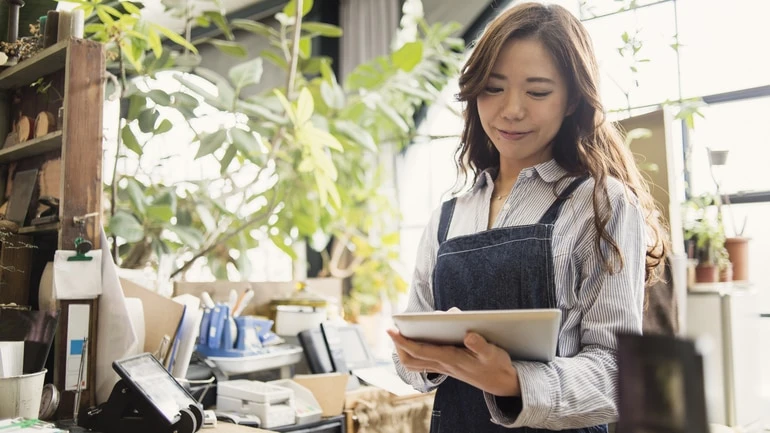
15 Benefits of a Restaurant iPad POS System
Naturally, the benefits of an iPad have not gone unnoticed by the hospitality sector. Below are 15 big benefits of implementing a restaurant iPad POS system:
1. Cost Savings
While an iPad restaurant POS might seem sleek and expensive at first glance, it’s actually a dramatically cheaper option compared to a legacy POS system.
If you purchase the proprietary hardware needed for a legacy POS system, you could be looking at $5,000 to $7,000 just for the hardware alone. On the other hand, a single-register iPad restaurant POS system will only set you back around $1,000 to $1,500 for the entire hardware setup.
2. Simple Setup
Implementing a legacy POS system in your restaurant usually means calling in a technician to set up your hardware and software – a process that’s not only complicated and time-consuming, but can also mean downtime that leads to lost revenue.
In contrast, iPad POS systems are designed for quick and easy setup – no technician required. In most cases, all that’s required to operate an iPad POS system is the iPad itself, the cloud-based software, and a credit card reader. This means that all the hardware and software can be set up on your own with the help of a how-to guide.
3. Mobility
The iPad was designed to be portable and this means a restaurant POS iPad is just as mobile.
Unlike many legacy POS systems, which are made up of fixed POS terminals, a restaurant iPad can be carried anywhere in your venue. For full service restaurants, the biggest benefit of this increased mobility is that servers can take orders tableside. And in quick service restaurants, staff can use the mobile tablets to take customer orders and accept payments from diners as they wait in line – the ultimate line-busting solution.
4. Saves Space
Just like British Airways saving room in the cockpit, iPads can be major space space-savers in your restaurant.
Many older, legacy POS systems consist of bulky hardware that must be stored on-site in one specific place. Just think of those fixed POS terminals that sit on a counter or at the host stand.
In contrast, iPads are incredibly small and compact, meaning they take up significantly less room on any counter. Not to mention, iPads are lightweight (only about one pound!) and wireless, which means they can be moved anywhere in the restaurant as needed.
5. Speed
If your restaurant relies on fixed POS terminals, orders aren’t actually sent to the kitchen until staff has a chance to punch them in, which could mean a significant amount of time between when a customer places their order and when it’s actually sent to the kitchen. Not to mention, if servers are punching in multiple orders at once, all those orders get sent to the kitchen at the same time, creating serious bottlenecks.
In contrast to those fixed legacy terminals, the iPad’s cloud capabilities and mobile design allow tablets to be taken tableside. This means servers can take orders right at the table and send those orders to the kitchen immediately. Not only does this allow the kitchen to begin preparing orders much faster, but it also means staff aren’t sending in multiple orders at once and slowing down the kitchen.
6. Accuracy
As mentioned above, restaurants that still use fixed POS terminals require servers to write down each order and then run back to the POS terminal to punch in the order. The problem is that this manual data entry leaves room for all kinds of errors – errors that cost both time and money.
But with an iPad restaurant POS and tableside ordering, staff can take orders and fulfill orders right at the table. Servers can even use the iPad’s visual display to confirm details with guests, significantly shrinking the risk of errors.
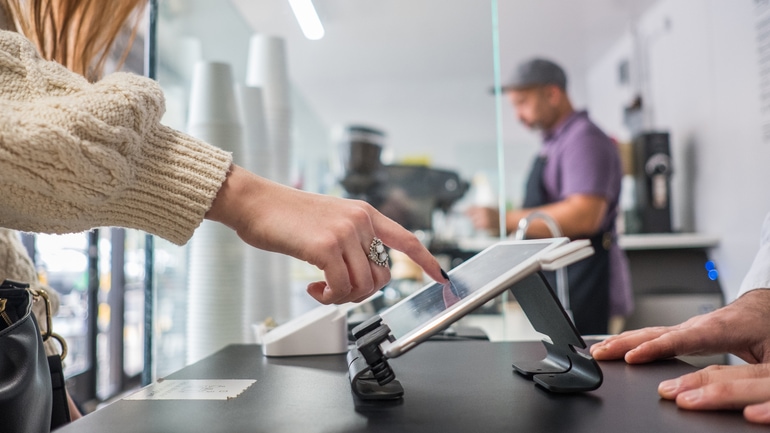
7. Durable
Restaurants are tough environments, which means you need devices that can withstand a few drops, scratches, or splashes. Luckily, the iPad is durable enough for most restaurants.
The iPad screen is made up of thin, scratch-resistant glass so you don’t have to worry about your servers scratching up the screens as they punch in orders. And with the addition of a simple case, you can protect the screen against any major damage.
8. Remote Data Access
If all your POS data is tied to the legacy devices located on-site in your restaurant, you have to be physically in your restaurant any time you want to make a change to your menu or look up a report.
But with a restaurant iPad, all your information is stored in the cloud. This means you can access your account from any Internet-enabled device like your phone or laptop. This is a major plus because it lets you manage virtually every aspect of your restaurant remotely from just about anywhere.
9. Low Learning Curve
One of the biggest barriers to switching POS systems is the process of training staff on how to use an entirely new system. Fortunately, a restaurant iPad has one of the lowest learning curves of any POS system out there.
iPads are designed to be intuitive and easy to figure out straight out of the box. This means that even staff who are used to legacy technology can easily figure out how to navigate an iPad’s basic functions.
And for younger staff who are more tech-savvy, restaurants like Cafe Crepe have found that there’s virtually no learning curve. When the restaurant made the switch from a legacy system to TouchBistro’s iPad POS system, it’s young staff members had no trouble learning the new system or using it on a daily basis. In fact, in just the first 30 days of switching to TouchBistro, Cafe Crepe noticed a significant drop in staff turnover – savings that translate to roughly $1,800 to $2,000 worth of resources per person.
10. Enhanced Customer Experience
Perhaps one of the greatest benefits of an iPad is that it translates into a better customer experience for your guests.
As executive chef and founder of The Peached Tortilla Eric Silverstein has found, taking orders tableside with a restaurant iPad allows servers to get orders in faster, which helps the kitchen get food out faster because tickets aren’t coming in all at once. He also notes that “there’s less room for error when you’re just punching in an order right then and there. Server’s forget things. They’re human.” And when guests receive exactly what they ordered in less time than they expected, it leads to a more positive dining experience.
Additionally, a restaurant iPad can be used to accept payments at the table, so your staff doesn’t need to take each guests’ credit card to the register and then bring back a receipt for them to sign. This dramatically speeds up services and can improve the overall dining experience for your customers.
11. Top-Notch Security
One of the reasons some restaurateurs have been slow to embrace iPads is over fears that a restaurant POS iPad isn’t as secure as a legacy POS system. And while no operating system is 100% secure, iPad POS systems are as close to iron-clad security as you can get.
Thanks to a top-notch combination of hardware and data encryption methods, Apple’s iOS prevents software and firmware from reading and stealing certain aspects of your device information directly. Apple also employs various user-controlled security measures, such as passcodes and time delays for incorrect passcode entries, to prevent unauthorized individuals from accessing devices.
Moreover, Apple employs end-to-end data encryption, which is the most effective way to eliminate any interceptions by third parties. In contrast, most legacy POS do not encrypt data upon capture, which leaves major security loopholes and makes the systems vulnerable to malware breaches.
12. Scalable
If your business grows, it means more pressure on your existing POS system. Therefore, it’s best to choose a POS system that’s easy to scale.
Most modern POS providers like TouchBistro offer single-iPad and multiple-iPad configurations, which means you can choose exactly the number of POS terminals you need. And if your business grows, you can simply add more POS terminals by purchasing additional iPads.
13. Seamless Updates and Easy Repairs
If you’re using a legacy system with fixed POS terminals, any major repairs or software updates require you to call in a dedicated technician. And if any of your proprietary hardware is damaged, often your only choice is to send it back to your POS provider for repair.
With a restaurant iPad POS system, there’s no need to bring in a technician or even call up customer support. The cloud-based nature of the iPad and iOS makes the software incredibly easy to update and patch. This means if there are software problems or bugs, updating things is as simple as the press of a button. And if your hardware is damaged, most issues can be fixed at your local Apple Store.
14. Aesthetic Design
Though aesthetics are subjective, there’s no denying that Apple iPads are generally associated with sleek, modern, and minimalist design. If you’re trying to convey the image that your restaurant is hip and forward-thinking, an iPad is a much better way to do that than an oversized piece of legacy POS hardware.
Aesthetics are especially important if you are using your restaurant iPad as a customer-facing display. Researchers have found that users are strongly influenced by the aesthetics of any given interface, and are more likely to view well-designed products – like an iPad – as easier to use. And ease of use is important because it can actually translate into better tips for your staff. According to a study by Software Advice, restaurants that began using an iPad say tipping increased on nearly 60% of credit card orders.
15. Ongoing Innovation
Technology is constantly changing, and you want to ensure that your POS system can keep with those changes.
With older, legacy POS systems, keeping up with the pace of technology may mean completely replacing all your old POS hardware every couple of years. But with iOS and an iPad restaurant POS system, you never have to worry about your devices lagging behind.
Apple’s forced upgrades ensure that your operating system is always current and in line with the latest security measures and industry standards. This not only ensures that your software is running at its optimum level, but it also helps to keep your customers’ information safe as technology evolves.
Based on the 15 reasons listed above, it’s clear that a restaurant iPad has a lot of advantages over a traditional, legacy POS system. Not only will the technology help you streamline operations and improve service, but it also leads to a better overall customer experience – all of which is good news for your bottom line.
Get the Complete Guide to Restaurant Reservations
Sign up for our free weekly TouchBistro Newsletter



